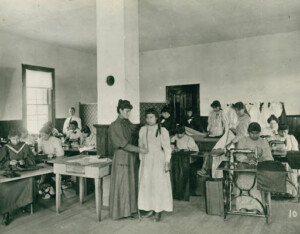Chemawa Indian School
” The Chemawa Indian School, at 112 years, is the oldest continuously operating boarding school in the United States and numbers its graduates in the thousands.”
The history of the Chemawa Indian School dates back to the 1870’s when the U. S. Government authorized a school for Indian children in the Northwest. The official philosophy at that time was to integrate the Indian population into general society through education. Two Indian schools were in operation on the East Coast.
A site was chosen at Forest Grove, to be administered by Pacific University. Lt. Melville Wilkinson of the U.S. Army and secretary to General 0. 0. Howard was in charge of the project. $5,000 was provided to start the school. Lt. Wilkinson, with the help of eight Puyullap Indian boys began construction of the buildings In 1880. Several factors lead to the search for a new site for the school: there was local resistance to the school, a much larger area of land was needed for teaching farming skills, and the girls’ dormitory burned in 1884. Willamette Valley towns considered for the school included McMinnville, Newberg, and Salem. Salem was chosen when the city offered 171 partially-cleared acres served by a spur of the main railroad through the Willamette Valley.
In 1885 the school moved to a site five miles north of Salem and construction of buildings began immediately. The first buildings were of wood construction and were later razed to make way for more permanent brick structures.
The first graduating class completed the sixth grade in 1886. Subsequently, courses were added through the tenth grade. In 1900 Chemawa had 453 students, the largest of its kind in Oregon and a federal budget of $57,182.62. The emphasis was on vocational training.
The 1913 report lists farming as one of the major areas of training. Dairying, stock raising and other farm methods provided food which was preserved by the students for later use. A school library provided reading material and religious training was provided; there was a Roman Catholic church on campus. Students could participate in basketball, baseball, and football. There were 690 pupils enrolled with 175 Alaskan children.
By 1922 there were 70 buildings on the 40-acre campus. Most of the buildings were wood frame, but some of the newer were of brick construction. The land area of the school had increased to 426 acres. Some of the land had been purchased by Indian students and given to the school as a token of their gratitude; most of the money for this land was earned by picking hops. The staff at that time numbered seventy..
The year 1926 saw the peak enrollment at Chemawa; almost 1,000 students were enrolled. The 11th and 12th grades were added to the curriculum and all grades below the 6th were dropped. In 1927 Chemawa became a fully accredited high school.
In an economy move the school was threatened with closure in the early 1930s, but due to the efforts of Interested Journalists and Oregon’s Congressional delegation, it remained open with 300 students. This marked a major change in policy and the school never regained its former number of students. Indian children were encouraged to attend local schools whenever possible. The school farm of over 300 acres was an important training site for the vocationally-oriented program.
The 1940s and 50s brought other changes to Chemawa. A special program for Navajo children expanded and northwest Indian children were schooled elsewhere. Another change of policy brought back Northwest students, particularly from Alaska. With the move to a new campus on adjacent land, most of the old brick structures were destroyed; only one building remains on the old Chemawa campus which has been declared eligible for the National Register. The Chemawa Indian School, at 112 years, is the oldest continuously operating boarding school in the United States and numbers its graduates in the thousands. (Wilson, NR Nomination, 1992) (MCHS 1959:37-42)
Bibliography:
Wilson, National Historic Register Nomination, 1992
Marion County Historical Society Quarterly, 1959
This article originally appeared on the original Salem Online History site and has not been updated since 2006.








Leave A Comment